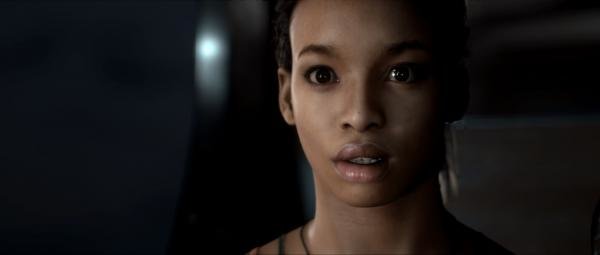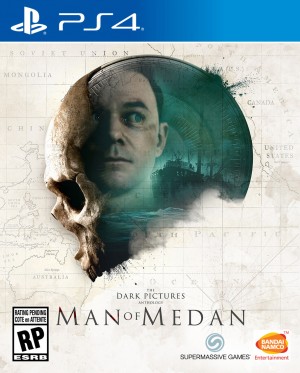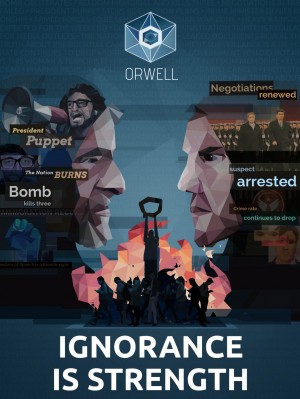Pete Samuels – Supermassive Games interview

When we last spoke to British developer Supermassive Games in September 2015, we had no idea what a surprise hit their PlayStation-exclusive horror adventure Until Dawn was about to become. Since that game‘s succesful launch, the studio has done anything but rest on its laurels, releasing several smaller projects for Sony's VR and PlayLink catalogue. With Supermassive's upcoming The Dark Pictures Anthology, though, the time of exclusivity is over as the team has joined forces with publisher Bandai Namco to release the series of interactive movies on PC, PlayStation 4 and Xbox One. With Man of Medan, the first entry in the anthology, aiming for a 2019 release, the time seemed right to chat with the game's director Pete Samuels for a behind-the-scenes glimpse into the horrors on the horizon.
Ingmar Böke: Hi Pete, and welcome to Adventure Gamers! You're currently working on The Dark Pictures Anthology, a series of cinematic games that explore different sub-genres of horror. Let's start out by discussing the overall concept, and the similarities/differences between the individual episodes.
Pete Samuels: Hi Ingmar. We started working on the Dark Pictures concept almost four years ago. We are massively excited about it! The concept, as you say, is for the individual games in the series to represent different sub-genres of horror. That means each game will have a different tone and set of tropes each time. There will be changes in the pacing of each story, with different protagonists – and antagonists – and that means a unique set of relationships between characters at the outset of each story. Essentially, all of our stories are about people and relationships. How these relationships are stressed depends on the nature of the horror in that game and, of course, the decisions that the player makes on behalf of the characters.
Ingmar: Please describe the story premise behind the first part of the series, Man of Medan.
Pete: OK, so, one other thing that’s common to each story in the series is that there is some kind of link between the horror and a real existing mythology, and even real historical events. Man of Medan draws on the myth of the Ourang Medan, a Dutch freighter that reported some strange happenings before the unexplained deaths of the entire crew shortly after the Second World War. Our premise is that a group of young Americans with an interest in wreck-diving WW2 sites gets caught up in a series of events that puts them on a ghost-ship in the South Pacific Ocean. Facing multiple human and non-human threats, they try desperately to survive the terror and escape the ship.
Ingmar: Like in Until Dawn, the aspect of choice and consequence will be very important. What can you tell us about the kinds of choices players will be able to make, and how far narrative branching might change the experience that different players are going to have?
Pete: How the story plays out is entirely driven by the players’ choices, each of which has consequences for their characters. This might be a single significant consequence to a single decision, which might play out immediately or set off a chain of events that manifest in a significant consequence some time later in the story. It may be that a decision nudges a relationship in a certain way, and an accumulation of those ‘nudges’ leads to, or avoids, a significant event further down the line. Man of Medan is significantly more branching than anything we’ve done previously, leading to multiple significantly different endings. As is our way, all of the playable characters can survive the story, and any of them can die as a direct result of the players’ decisions and actions.
Ingmar: Are there any particular lessons from Until Dawn and your other games that you're trying to implement into The Dark Pictures Anthology?
 |
Pete Samuels |
Pete: One key learning has been how much people enjoyed horror in this format, individually and with friends. Until Dawn hadn’t been released for very long before people were calling for a sequel. This was one of the reasons we decided on the Anthology format as it allows us to release new games more often than once every few years. We have introduced a dramatic change in our production model to accommodate this. As of today, the first four of the games in the Anthology are in progress at different stages. Man of Medan is obviously in its latter stages of production, slated for release later this year. The second game is also in production, at an early stage. The third is largely designed and the dialogue script being written for recording later this year, and the fourth is in story development. They’re all horror, they’re very different from each other, and we’re equally excited about each of them.
Ingmar: Aside from its playable prologue, Until Dawn burned slowly at first before things escalated, taking time to thoroughly introduce its characters. What can you tell us about pacing in Man of Medan?
Pete: The pacing in Man of Medan isn’t dissimilar. There’s a playable prologue that sets up an instigating event, followed by some time to get to know and, to some extent, form our characters and their relationships before the terror kicks in.
Ingmar: Unlike your previous games, The Dark Pictures Anthology is going to be a multi-platform series for PC, PS4 and Xbox One. Is the PC version going to allow playing with a keyboard and a mouse? If it does, would you still recommend using a controller anyway, or will there not be much difference when it comes to the ideal experience?
Pete: We will be supporting keyboard and mouse for PC and I’d encourage people to play with whichever input method they are most comfortable. I think that’s the way to have the best personal experience.
Ingmar: What kind of play time are you estimating for a single playthrough of Man of Medan and its successors?
Pete: We’re targeting a single playthrough time of around four-and-a-half hours for each game in the series. However, this will vary depending on how exhaustively players search the environment for information and, to a degree, the decisions that they make and the scenes that they experience as a result. Man of Medan has the most branching of any game we’ve made and is designed to be hugely replayable.
Ingmar: Let's talk about inspiration: What horror movies/TV series/games have had an impact on The Dark Pictures Anthology?
Pete: We have many influences. Each story has its own influences from film, TV, games, books, radio… but the things that have influenced our anthological approach have been TV series such as The Twilight Zone and Black Mirror, and films like V.H.S. When people play Man of Medan, the most obvious places to find influence will be films such as Ghost Ship and Triangle because they are clearly ghost ship stories. But look more closely to find influences from all sorts of supernatural horror, such as Insidious and The Shining, amongst others…and even from other genres, such as Home Invasion. These influences are important in what we do because we’d like players to recognise situations and be able to weigh-up the possible consequences of their choices based on their own experiences. Not many will have faced these terrors in real life…we hope…so will rely on what they’ve read, heard or seen on a screen to determine what an outcome might be.
Ingmar: While I'm a big fan of the horror anthology idea in games, I imagine this must be an enormous amount of work. In your case, it wouldn’t seem like you can recycle much material (locations, assets etc.) from one episode to another like other series do. Not to mention that each of your titles will have narrative branching and performance-capturing. Please give us an idea of the production process of the series and the challenges you expect to arise.
Pete: It’s not an insignificant challenge, for sure. As I’ve said, having multiple titles for the series in development at the same time is key to the Anthology’s success. If the release dates are more than a year apart then it kind of defeats the purpose of building it as an Anthology, so our aim is to release two games per year. Each game requires two or three performance capturing sessions of three or four days for voice and face capture, and many body-mocap and stunt shoots. We’re hitting a beat of six months story development, six months game design, six months production and six months post-production and editing…approximately…for each game. It’s quite a pace and it’s fairly constant, so looking after the welfare of the team is a key priority for us.
Ingmar: You're using a different engine than you did for your previous games. What kind of pros and cons have you encountered so far when it comes to the Unreal Engine 4?
Pete: Man of Medan is our first multiplatform game (PS4, Xbox and PC) and we needed to move to a proven multiplatform engine. UE4 gave us a great deal of ‘out-of-the-box’ advantages. We’ve been using UE4 for a few years now and, like any new engine, we’ve had to work hard to purpose it to the things that are important to us in our games. We’ve built substantial tools and systems to help us with that.
Ingmar: It would be fascinating to get a better understanding of your performance-capturing process. Can you walk us through a standard filming session, and the process as a whole?
Pete: First thing to say is that we capture face and voice in one process with our cast of actors, and body as a separate process using specifically trained motion-capture and stunt performers, then ‘piece’ the two together in Unreal. We go to our ‘performance’ (face and voice) shoots armed with the game’s script, mood boards and full storyboards for every scene so that the actors get a full appreciation of the environment, the pace, and where each scene that they’ll shoot fits into the overall scheme. Of course, they’ve already seen the scripts and the full character bios, so they’ve prepared for the shoot before they arrive. We don’t expect actors to be off-book. There would be way too much to memorise in our branching narrative. We provide teleprompt for lines on the stage and, we think, run a highly efficient and productive shoot, with a professionalism that’s brought to the set by a seasoned 1st AD [First Assistant Director] from film and TV, alongside our own Production and Direction people. We always encourage the talent to bring something of their own interpretation to the character, and we record in groups, so the stage is often occupied by three or more actors at the same time, bouncing their lines off each other. It’s a lot of fun for us to see the scripts brought to life in this way and, we’re regularly told, a lot of fun for the talent.
Ingmar: What's your personal take on the "uncanny valley"? [The problem of human simulation being so close to realism that it draws noticeable attention to the discrepancies] Do you see it as one of the main challenges for developers working on cinematic games?
Pete: It’s a challenge, for sure. Almost by definition, the closer we get to perfection without achieving it, the more ‘uncanny’ it becomes! So, we could give up, and change style, or continue in pursuit of that perfection. We’ve chosen the latter as our preferred route, and we believe that most people who play our games would prefer that. All we can hope and strive for is that the emotion we deliver through our characters overrides any imperfection. Of course, everything we do is done in run-time, not ‘canned’ or pre-rendered, and it can be one of many things that throws off the believability, such as lighting, data streaming, texture memory…all of which are managed dynamically at run-time…which increases the challenge for us. That said, we have an extremely talented and technical team here in the studio, and I believe that the results achieved by the team are pretty remarkable.
Ingmar: Genres aside, when it comes to storytelling, which games from recent years have particularly impressed you?
Pete: I’ve been impressed by so many over recent years. Great storytelling is becoming so much more prominent in all game genres and more and more studios are employing the right talent to deliver stories well. I’m a huge fan of Naughty Dog and can’t wait for The Last of Us 2. The first was one of my favourite games of all time. Then there’s the most recent Red Dead Redemption and God of War games, and Hellblade, all of which stand out with their tremendous narratives.
Ingmar: Before we come to an end, what’s the latest estimated release date for Man of Medan and its follow-ups?
Pete: Man of Medan will release in 2019. We expect to announce a date quite soon. The next game in the Anthology will release approximately six months after that, and we can hardly wait to talk about it.
Ingmar: Thanks a lot for doing this interview. Much appreciated, and all the best with The Dark Pictures Anthology!
Pete: Thank you. It’s been a pleasure.
















